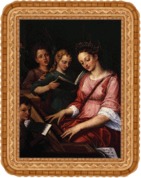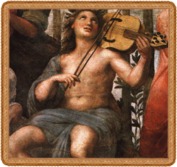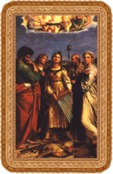|
  
 The Renaissance (15th century and
on)
The period whose name means "revival" begins
in Florence
The Renaissance (15th century and
on)
The period whose name means "revival" begins
in Florence ,
Italy, with the attempt to revive the art of the
classical Roman time. That is why people of this age view the previous
era as "the middle ages" (or worse - "the dark ages")
of waiting for this revival. Renaissance architecture reinstituted many
classical elements, updated to the new era, including columns,
arches and triangles above lintels.
The invention of perspective
in painting, among renaissance's greatest contributions, is articulated
by Brunelleschi ,
Italy, with the attempt to revive the art of the
classical Roman time. That is why people of this age view the previous
era as "the middle ages" (or worse - "the dark ages")
of waiting for this revival. Renaissance architecture reinstituted many
classical elements, updated to the new era, including columns,
arches and triangles above lintels.
The invention of perspective
in painting, among renaissance's greatest contributions, is articulated
by Brunelleschi ,
who was a prominent architect at the time. He took reference to size reduction
in pictures, in accordance to distance, thus allowing three-dimensional
objects to be drawn.
Renaissance sculpture presents human figures, deliberately
not beautified, sometimes even grotesque, as in real life. In both painting
and sculpture, artists did not describe according to what was customary
before, but studied how people look, how they move etc. The
will to achieve a natural, genuine description of figures and reality drove
artists to the outdoors and nature, in order
to paint it, and to use live models for the first time.
Oil paint, developed during
this period by van Eyck ,
who was a prominent architect at the time. He took reference to size reduction
in pictures, in accordance to distance, thus allowing three-dimensional
objects to be drawn.
Renaissance sculpture presents human figures, deliberately
not beautified, sometimes even grotesque, as in real life. In both painting
and sculpture, artists did not describe according to what was customary
before, but studied how people look, how they move etc. The
will to achieve a natural, genuine description of figures and reality drove
artists to the outdoors and nature, in order
to paint it, and to use live models for the first time.
Oil paint, developed during
this period by van Eyck ,
was an excellent means of achieving the desired precision in description
of reality.
Piero della Francesca ,
was an excellent means of achieving the desired precision in description
of reality.
Piero della Francesca innovates this with his presentation of light and shade. Botticelli
innovates this with his presentation of light and shade. Botticelli presents harmony by symmetry
(a balance between different sides of a painting), motion and counter-motion
(much like the counterpoint
presents harmony by symmetry
(a balance between different sides of a painting), motion and counter-motion
(much like the counterpoint in music), and perfect beauty and exploration of the human body
along with it.
Artists liberated themselves from
the yoke of the church and became valuable and important. Nobles
and princes are their new employers, however, still as artistic servants.
The renaissance artist is usually also a scientist
and a researcher, a person of knowledge in anatomy, optics and other
topics. To this very day, a person who obtained knowledge in diverse subjects
is called "a renaissance man" or "a renaissance woman".
Leonardo da Vinci
in music), and perfect beauty and exploration of the human body
along with it.
Artists liberated themselves from
the yoke of the church and became valuable and important. Nobles
and princes are their new employers, however, still as artistic servants.
The renaissance artist is usually also a scientist
and a researcher, a person of knowledge in anatomy, optics and other
topics. To this very day, a person who obtained knowledge in diverse subjects
is called "a renaissance man" or "a renaissance woman".
Leonardo da Vinci ,
who painted the most famous painting in history - the "Mona-Lisa" ,
who painted the most famous painting in history - the "Mona-Lisa" ,
was a musician and an inventor (he even invented the first helicopter,
although the idea was not applied during his own life), and an anatomist.
In the Mona Lisa he invented the "sfumato"
('smokey in Italic) - blurred defining lines of the figure and vague contours.
Those gave the painting its well-known mystery and the sensation of permanent
change and altering moods.
Giorgione ,
was a musician and an inventor (he even invented the first helicopter,
although the idea was not applied during his own life), and an anatomist.
In the Mona Lisa he invented the "sfumato"
('smokey in Italic) - blurred defining lines of the figure and vague contours.
Those gave the painting its well-known mystery and the sensation of permanent
change and altering moods.
Giorgione presents, for the first time, a landscape painting per se, meaning
a picture in which the view is part of the subject, not just the background.
This novelty turns painting from a colour-painted drawing into a meaningful
art with rules of its own.
presents, for the first time, a landscape painting per se, meaning
a picture in which the view is part of the subject, not just the background.
This novelty turns painting from a colour-painted drawing into a meaningful
art with rules of its own.
|